Samsung Galaxy S III Review - AT&T and T-Mobile USA Variants
by Brian Klug on June 20, 2012 12:01 AM ESTWe’ve already seen dual core Krait (MSM8960) performance before and talked about it in the HTC One X (AT&T) review. For the most part, what we see with the USA SGS3 variants is largely the same as what we saw in MSM8960 (or MSM8260A, the same part with different baseband).
If you’re looking for a comparison to the International SGS3 with Exynos 4412, my unit hasn’t quite arrived yet. Anand and I plan to take a comprehensive look at the SoC performance landscape (Tegra 3 / MSM8960 / Exynos 4412) in another review after we’ve had time with the international SGS3. I have benchmark numbers from our SGS3 international preview at the launch event, but those were from pre-final software.
Where the SGS3 differentiates itself from what’s becoming a slew of USA-bound devices with MSM8960 is available RAM. In this case, all of the USA SGS3s include 2 GB of LPDDR2 RAM, of which 1.62 GB is available to user applications. My own suspicions for why this is the case is that Samsung wanted to make sure they had at least 1 GB available for user space applications. Clearly there is 380 MB absorbed for both preallocated GPU memory, and possibly DRM / baseband, and after that subtraction the only way to get dual channel (2x32b) LPDDR2 is to make the jump to two 1 GB LPDDR2 devices.
That’s my own speculation, but either way with the SGS3 you get ample RAM for applications. The positive thing is that even if you launch a ton of applications, it’s unlikely they’ll get tombstoned. I fired up my regular set of daily driver applications (twitter, baconreader, chrome, messaging, speedtest, radarscope, and a few others) and managed to use up nearly 1 GB.
JavaScript Performance
Although smartphones are clearly headed for a life beyond as a communications tool, web browsing, or phone duties, we are still lacking the tools to measure performance in areas other than a component of web page performance. Measuring JavaScript performance is one component of the entire web page rendering process but it’s the most mature in terms of something we can benchmark.
Sunspider 0.9.1 is quite possibly the most well known of these JavaScript tests, and a regular staple of our testing suite:
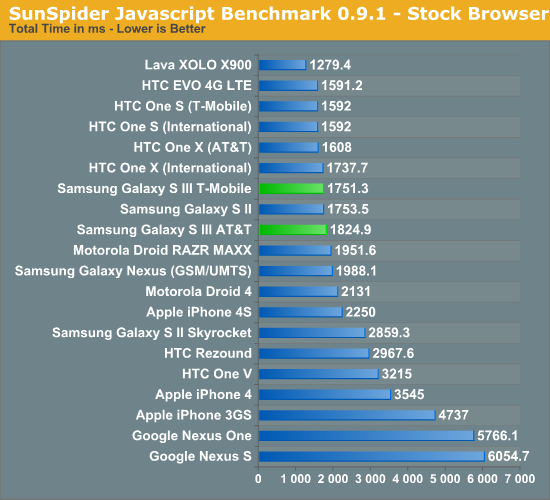
Like the other 1.5 GHz MSM8960 devices, the SGS3 does pretty well, but still is around 150ms slower. I ran this test multiple times but consistently got results in the 1750s or low 1800s for the SGS3s.
Browsermark is the next JavaScript test in our suite, and here it does very favorably against the rest of the competition.
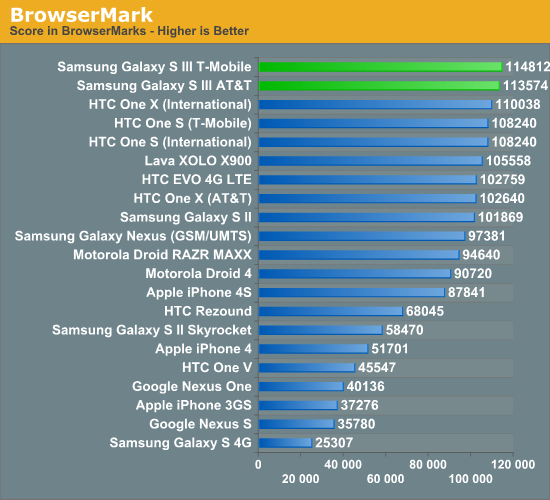
It’s interesting to see the SGS3 not do stellar in Sunspider, but excellent in Browsermark. Note that in our preview piece, I did see the International SGS3 post a score of 161k here.
Next up is Vellamo, which is a Qualcomm benchmark developed originally for OEMs to use and optimize their browser performance, and later released for general use. It’s a regular member of our test suite and includes both JavaScript tests and scrolling tests that stress the display composition and hardware acceleration in the browser.
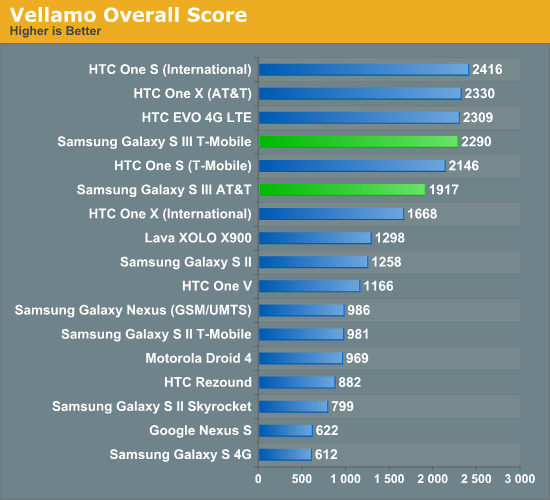
I saw an interesting deviation here between the AT&T and T-Mobile version, for reasons I cannot explain despite multiple reboots and making sure everything was closed. Either way, the devices both have stock browsers that feel like butter, absolutely smooth when translating or zooming around.
Low Level FP Performance
Linpack isn’t a great indication of overall smartphone performance, but it is a good test of the floating point capabilities of the CPUs in these SoCs. ARM has steadily been improving FP performance for the past few generations but we’re going to see a big jump to Krait/A15. As most client smartphone workloads are integer based and those that are FP heavy end up relying on the GPU, an advantage here doesn’t tell us much today (particularly because Linpack isn’t running native code but rather atop Dalvik) other than how speedy the FPUs are. There’s a new port of Linpack which runs using native code which we’ll be trying out in the big performance comparison piece.
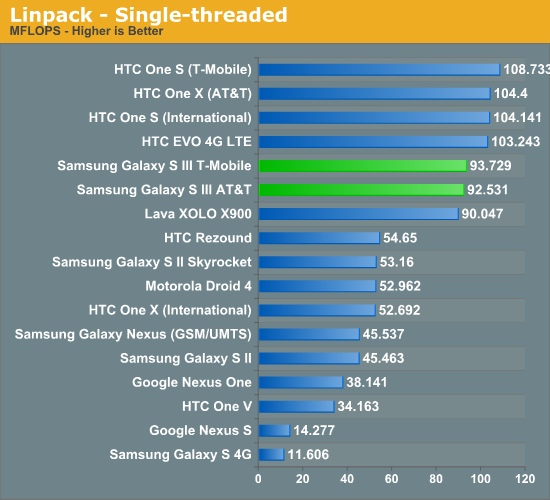
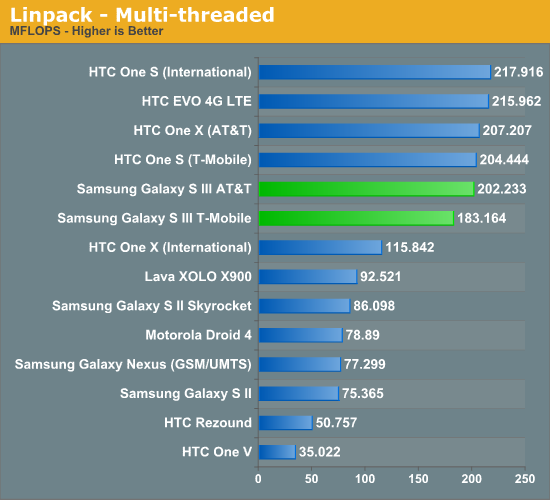
As we’ve shown before, FP performance on Krait is superb thanks to its architectural advantages over a straight A9. I find that FP performance was more relevant of a benchmark when display rendering was being done in CPU instead of on the GPU with the new OpenGL ES 2.0 render paths. Still, it’s worth talking about.
BaseMark OS
Rightware’s BaseMark OS is a general purpose benchmark designed to better simulate overall Android performance. It includes a heavily threaded benchmark, file IO tests, and compression/decompression tasks that all contribute to its overall score.
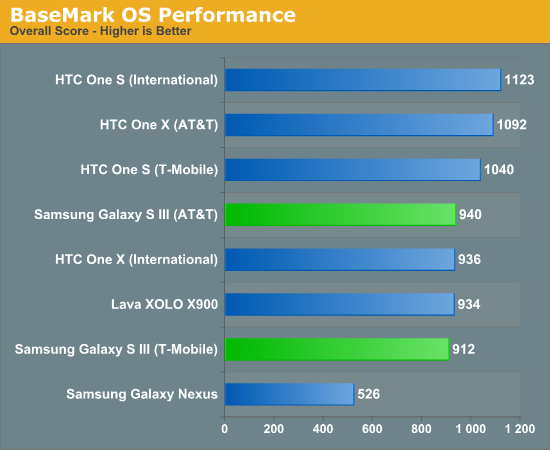
Basemark OS is relatively new to us but we’re adding more and more phones as time goes on for comparison purposes. Curiously enough the SGS3s post numbers a bit shy of their HTC cousins. I think that in spite of this, you’d be hard pressed to tell the Krait based One X and Krait based SGS3 apart.
GPU Performance - GLBenchmark 2.1
As we wait for actual 3D gaming benchmarks to make their way into Android (and hopefully crossplatform) games, we must rely on synthetic tests designed to simulate 3D game performance as best as possible. We start with GLBenchmark, one of the better Android GPU tests on the market today. There are two benchmarks, Egypt and Pro, and each is run in two modes: native screen resolution and offscreen (vsync disabled) at 720p. The latter is more useful for apples to apples comparisons as everything is rendering the same number of pixels, whereas performance in the onscreen tests is determined by the screen resolution of the device along with the performance of its GPU.
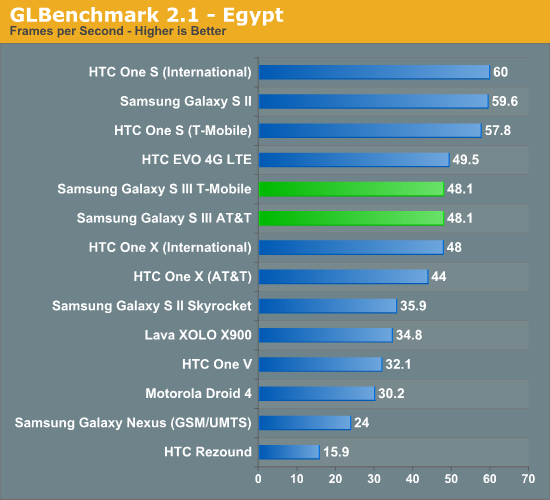
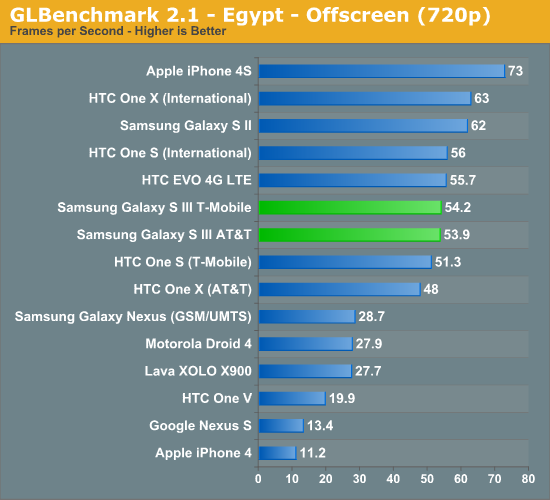
As a reminder, only the Egypt offscreen test takes place with vsync turned off, which is why you see devices with 720p displays posting different results on versus off screen where vsync is off. Part of the deal in getting Krait to market as quickly as possible required that Qualcomm pair the CPU with an older GPU, in this case the Adreno 225 instead of the newer Adreno 3xx offerings due out later this year in SoCs like MSM8960 Pro or the quad core Krait APQ8064. As a result, you can see the SGS2 with Exynos 4210 pull ahead in both tests. Obviously the on-screen test isn’t a totally fair comparison because of the inherent difference in resolution - 720p vs WVGA.
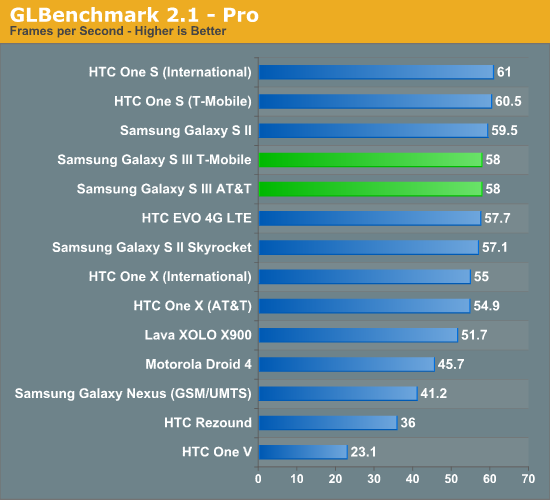
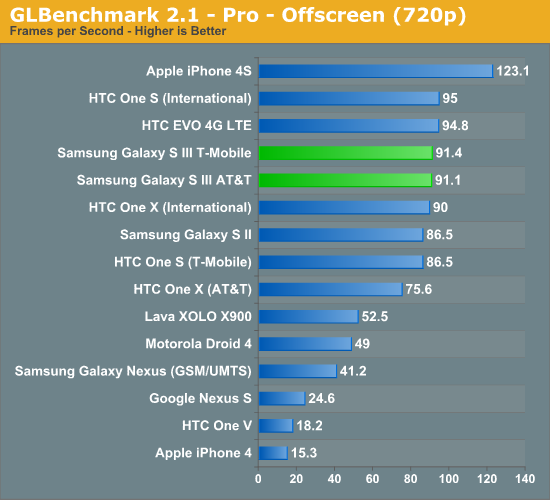
In the older Pro offscreen test, we see Adreno 225 trading spots with SGS2’s Mali–400 and coming out on top.
Basemark ES 2.0 V1
Rightware’s Basemark ES 2.0 V1 is an aging GPU test that tends to favor Qualcomm’s Adreno GPUs above almost all others:
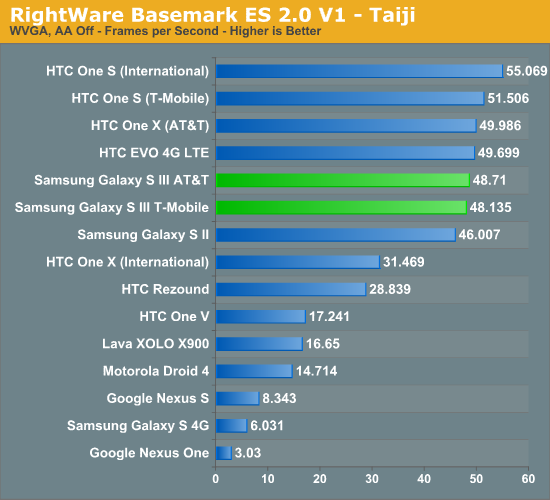
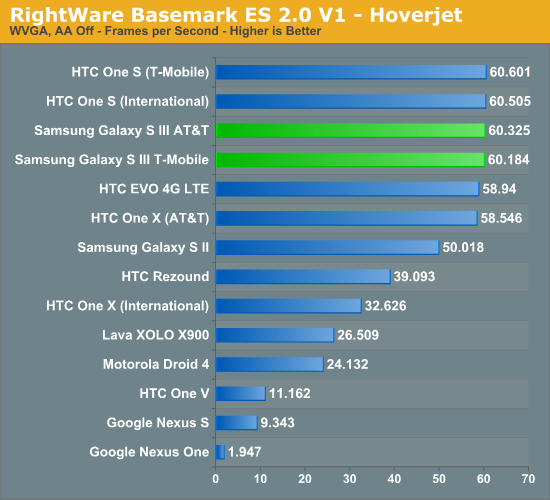
Basemark ES 2.0 is definitely starting to show its age, as Hoverjet is at vsync essentially the whole time, and Taiji is getting there as well. In addition, Qualcomm appears to be using ES 2.0 as an optimization target, so I wouldn’t put too much faith in the ES 2.0 results.


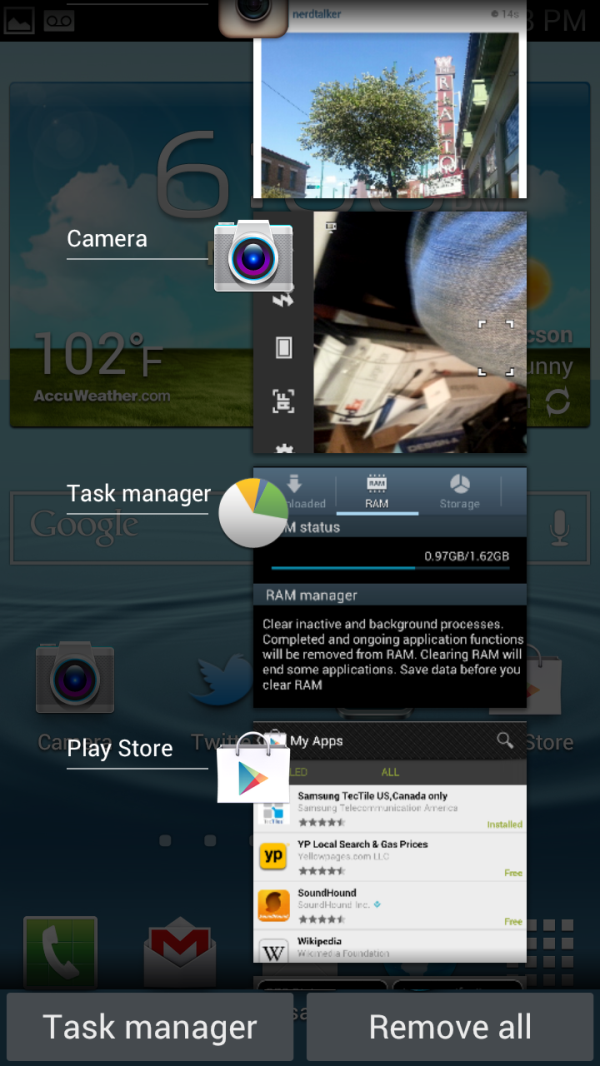
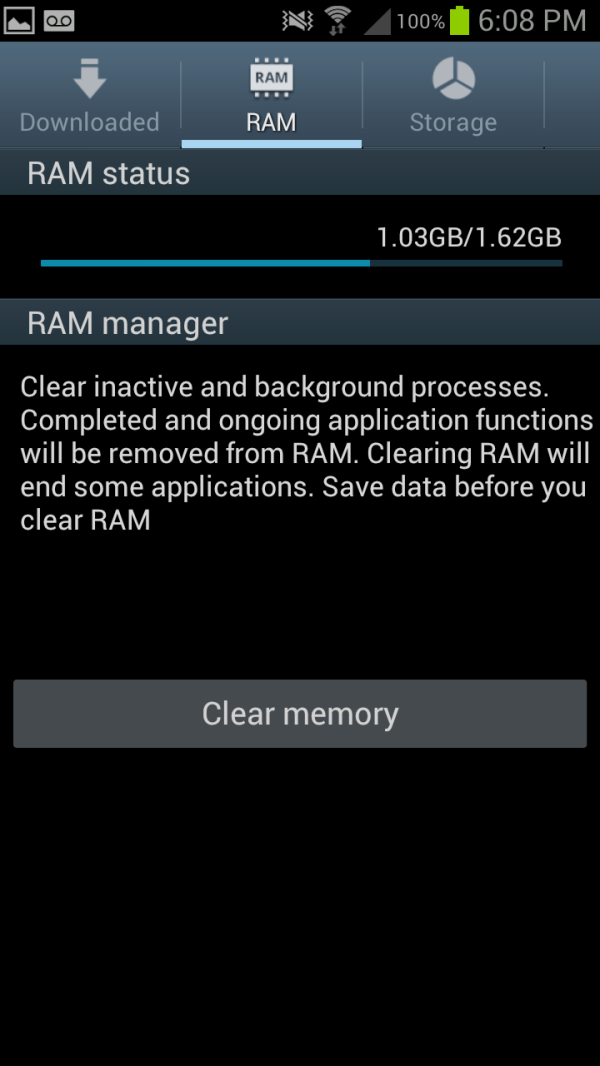








107 Comments
View All Comments
apoorvnaik - Thursday, June 21, 2012 - link
http://support.t-mobile.com/docs/DOC-4448This link says that the phone supports Band I, V, II and AWS.
Does that mean it is a pentaband ?
I'm totally confused by looking at so many different specs. :(
Mnalley95 - Thursday, June 21, 2012 - link
I am currently deciding between the one x and the sgs3, and the two most important factors to me are the battery life and the RAM differences. Nearly every other site has the one x with pretty awfu battery life in their tests, usually with the galaxy nearly doubling the results, but on all of your tests the one x appears fantastic, which is great. All I want is to be able to use my phone at least 12 hours with moderate to heavy use on LTE, so the differing battery results on different sites concerns me. Is there any explanation for this, anyone? Also, the RAM difference could be big in future OS updates, does anyone agree? Which device would be the most future proof? The sgs3 is also easier to hack and will probably have a larger community behind it, which is important. I think I personally like the one X better overall, but if the galaxy beats it in the categories I mentioned I would definitely be happy with it instead. Anyone that cares to share their opinions and answer my questions would be appreciated.Eridanus - Thursday, June 21, 2012 - link
It's a good thing the S3 has an SD card reader, unlike the Nexus.(Am I going to get censured again?)
ItsaRaid - Thursday, June 21, 2012 - link
Brian, both reviews were awesome- how do you cut through the chase and garbage.? Which is the better of the 2? Lets throw away all the crazy stuff, preferences, UI's bells and whistles. I HAVE A Nightmare with a Atrix2 and AT&T. I don't want to duplicate it.Wifi connectivity, receive signal functionality, browser use....lag, forced closes, move up or down on a page, my A2 will freeze and won't flick IP or down on a page. It took over a.Monte to load Annand tech on this phone! Audio output is critical to me, I have a sensory hearing deficit. How does the amount of volume compare to the Atrix2. That's all the good the A2 has...lots of volume and a bright crisp display.
I hope you will respond to this.
Thank you!
Narcopolypse - Thursday, June 21, 2012 - link
The reason S Voice responds so much like Siri is because they both query Worlfram Alpha (an independent system owned by neither company) for their answers. SRI (the company that made Siri) just added in a fake conversation system (20 year old tech) to tell you lame jokes and act like a back talking bitc# when it can't find an answer for you. None of this is new. And yes, Apple has already sued over it and tried to have sales of the GS3 banned in the US.steven75 - Friday, June 22, 2012 - link
Or it could be that S Voice is pretty much a complete clone of Siri from the interface to the functionality. Voice control isn't new, but the complete cloning should be obvious to even the most egregious Android/Samsung fanboy.If we can't agree on that, then we'll probably disagree on other things such as whether 2+2=4.
iCrunch - Sunday, June 24, 2012 - link
Oh come on, I've read multiple reviews and they are 100% consistent in concluding that Samsung's S-Voice doesn't come anywhere close to being as good or accurate or whatever as Apple's Siri. Is my troll/BS detector set to too sensitive or am I picking up some actual trolling here?uhuznaa - Monday, June 25, 2012 - link
Some people seem to think that this needs just voice recognition and a web service to turn to. In fact the real problem here is actually making sense out of what the user said and this is not just a technical problem.I have no idea where Samsung got/bought/licensed the AI here, but I wouldn't be at all surprised if the SRI stuff Apple got its hands on were better.
ProPhotoman - Tuesday, July 3, 2012 - link
I bought a GS3, and the total ram is only 1.6GB .I checked two more in the store, and they are the same. Why is Samsung publishing it as 2gb?cmdrdredd - Thursday, July 5, 2012 - link
A portion is reserved for system usage.